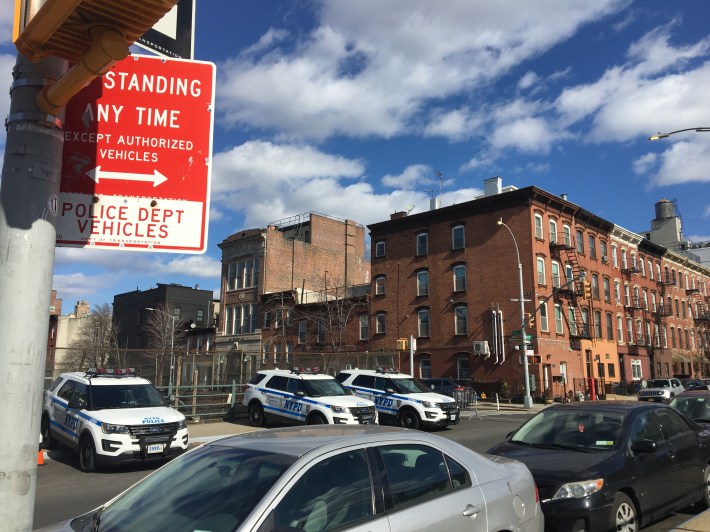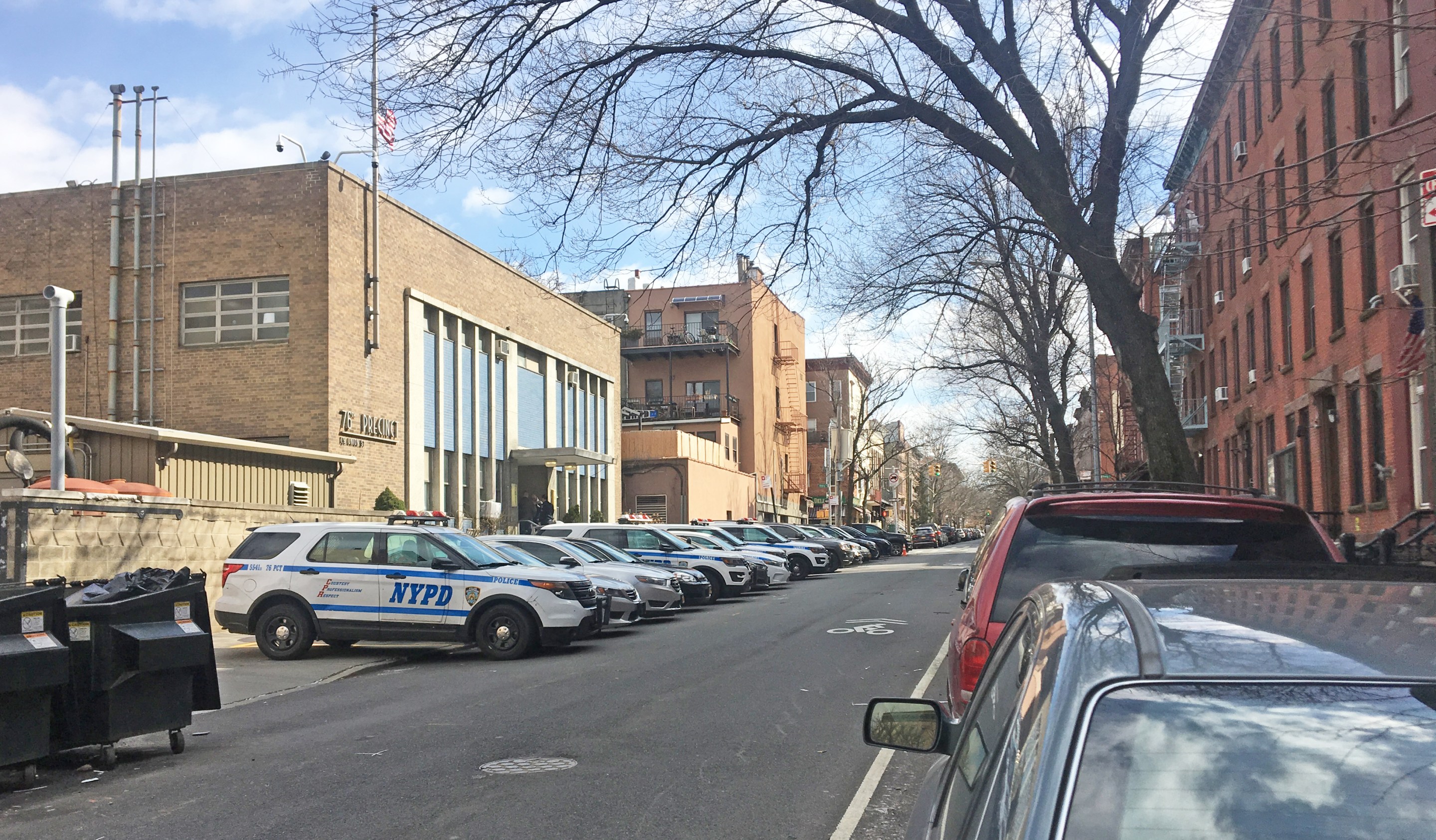Mayor de Blasio’s proposal to build or lease parking spaces for city cops and firefighters makes no sense from an environmental or congestion standpoint — and that's abundantly clear when you’re standing on Union Street in the tony neighborhood of Carroll Gardens trying to envision just how Hizzoner will make good on his latest handout to cops.
As the mayor — and placard-abuse watchdogs — have rightly pointed out, the streets around station houses like the 76th Precinct are clogged with cops' personal cars, which take parking away from neighborhood residents and choke the streets with extra cars and drivers circling looking for parking. This creates congestion, befouls the air, and makes residents livid.
And, most important, building more parking spaces for cops would unwittingly bring more danger to the very neighborhoods cops serve.
Streetsblog wrote down the plate numbers of the cars parked on the Union Street sidewalk on two separate days and ran them through the indispensable website howsmydrivingny, which collects all parking ticket, red light camera and speed camera violations. What we found would be shocking ... if we didn't always find similar reports:
In all, 26 out of 34 personal cars parked in police-only spots outside the station house had at least one ticket. Twenty of the 34 had at least one speeding or red-light violation, a far more serious offense (and 10 of the 34, or roughy 30 percent, had multiple serious violations). Here are the worst offenders (reminder: school zone speed cameras cover only 140 schools and are only on during school hours):
- One cop had 33 violations, including seven school zone speeding violations and two red light violations.
- One cop had 21 violations: three for speeding and four for blocking a fire hydrant.
- One cop had 19 violations, including three for failing to stop at a red light and four bus lane violations.
- One cop had 17 violations, including seven speeding tickets.
- One cop had 11 violations, six for speeding, three for blocking a bus lane and two for running red lights.
- One cop had eight violations, six for speeding in a school zone.
The mayor has often discussed the danger that a single reckless driver can do in a residential community. Creating more parking at the city's 77 station houses, many of them in residential communities, would put more scofflaws on the street because it would encourage more cops to drive.
In case you’re hearing that @NYCMayor announced a placard crackdown today, please read the truth from @dahvnyc, who reminds us that the mayor is simply unable to say “No!” to car owners.https://t.co/D7QqjgjdBU pic.twitter.com/y9VY8hjVr5
— Streetsblog New York (@StreetsblogNYC) February 22, 2019
That's already happening in Carroll Gardens, where the mayor has already added more and more parking for police officers. Eighteen police officers' cars are crammed vertically into 10 curbside spaces in front of the Union Street station house. There are also six reserved NYPD spots on a bridge over the Brooklyn-Queens Expressway further down Union. One block over, a bridge on Sackett Street has about eight spots reserved for the NYPD. Hicks Street has space for nine cars on two corners. Two of those spaces, Hicks near Degraw, were just added with a new sign reading, “Authorized Vehicles Only–Police Dept.” Last week, those spaces held two private vehicles parked with an NYPD placards.
Obviously, this is an untenable situation. So last month, at a recent press conference convened to unveil his new approach to illegal parking by his own cops and tens of thousands of other city employees, the mayor proposed building or leasing parking lots for officers. The mayor said:
We can designate more and more parking spaces in the community for our uniformed officers and make very clear to them that that's where there will be enough parking for them. .... We can also — and we will — purchase parking lots, we will lease parking lots, parking garages, whatever it takes — and this will take time, but we're going to move very quickly — so that our firefighters, our police officers, our EMT’s actually have a place that they know they can park so they don't need to be someplace that takes away parking from neighborhood residents or the customers of small business. Until we give them that good option, of course, many officers will feel they have no choice. ... This is a very worthy investment – it’s fair to our employees but also fair to our neighborhoods. ... Our uniformed officers do something very, very special and very powerful for this city, and they deserve special consideration.
How would that play out in Carroll Gardens? Not well at all.
The neighborhood that comprises the 76th Precinct is similar to many city places where cops work: it is heavily developed, with very little vacant land and soaring real estate prices.
A 2,000-square-foot lot at 153 Van Dyke St. sold for over $3 million in September, according to city records (and that was just for the land — building a garage would cost even more). Also, that lot is a mile from the station house. in an area with far lower real estate costs. The closest vacant land near the station house is on Degraw Street was sold in March 2018 for $1.25 million, city records show.

There is also a vacant lot on Union Street between Columbia and Van Brunt streets owned by the Dolcemascolo family that can hold roughly 15 cars. It would easily sell for $3 million, based on area land values, if it was ever listed on a very hot real estate market.
Individual parking spots are a hot commodity as well. A single condo parking spot on Tiffany Place around the corner from the lot on Hicks street was sold for $125,000 in August, city records show.
The mayor hasn't said much about — or put a price tag on — his proposal since airing it last month. A City Hall spokesman said the city is currently surveying all of the NYPD and FDNY parking needs so that the de Blasio administration can then evaluate how to move ahead on leasing parking lots, building parking structures or just setting aside more on-street spaces for cops.
But the mayor has made it clear that he considers free parking a perk for New York's Finest and Bravest.
"We’re also asking our officers often to stay all sorts of hours because of overtime needs or to come in the middle of the night or whatever it may be [so] we can do better at providing them a way to park near where they work," the mayor said last month. "Our uniformed officers do something very, very special and very powerful for this city, they deserve special consideration."
The mayor mentioned recently slain NYPD Detective Brian Simonsen, a Long Island resident, who "would drive 70 miles each way, each day [like] a lot of our officers ... coming in from very far away for objective reasons, the cost of housing in the city and etc." The mayor did not mention raises for police officers, which could help offset higher real estate costs in New York City and reduce the number of cops — currently 51 percent — who live outside the city, according to NYPD spokesman Lt. John Grimpel.
The base salary of an NYPD officer is $85,292 after five years — which is roughly $35,000 more than the median income in the city. It is inaccurate for the mayor to say that cops cannot find affordable housing in New York City, given that most of the city's adult residents earn far less than cops, yet also live here, as this income map from Business Insider shows.
Clearly some other factor is at work when only 49 percent of officers chose to live in the city they serve.
"Are we still pretending cops and teachers self-segregate in the suburbs because of the 'economic anxiety?'" Twitter user @rejini mused after Streetsblog tweeted recently about city economics and police commutes.
Marco Conner, the interim co-director of Transportation Alternatives slammed the mayor for the parking lot plan.
"Building parking garages is not the solution to placard abuse," he told Streetsblog. "When you guarantee parking, you guarantee driving, and you end up back with the status quo. You have to deal with the underlying problem by removing the incentives for driving. The mayor has been doing the exact opposite. ... How does this fit with the Mayor's sustainability goals and Vision Zero?
"Unfortunately it seems the Mayor has more in common with police officers who live outside of NYC: He doesn't ride the subway or take public transit, he likes to drive when he shouldn't, and he doesn't bike," Conner added.






